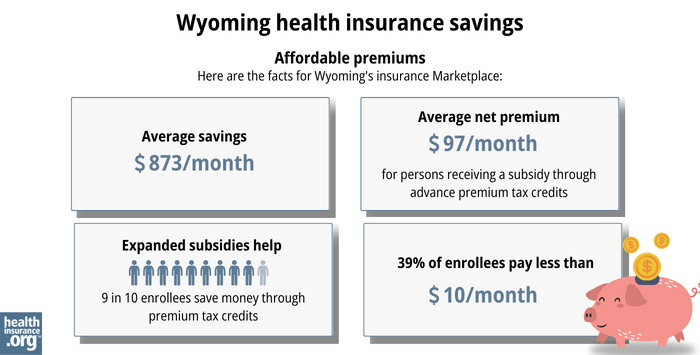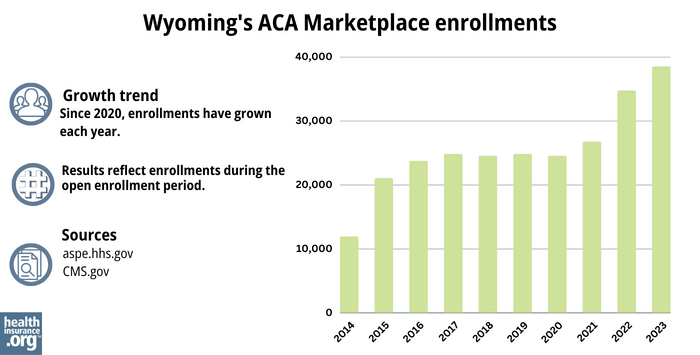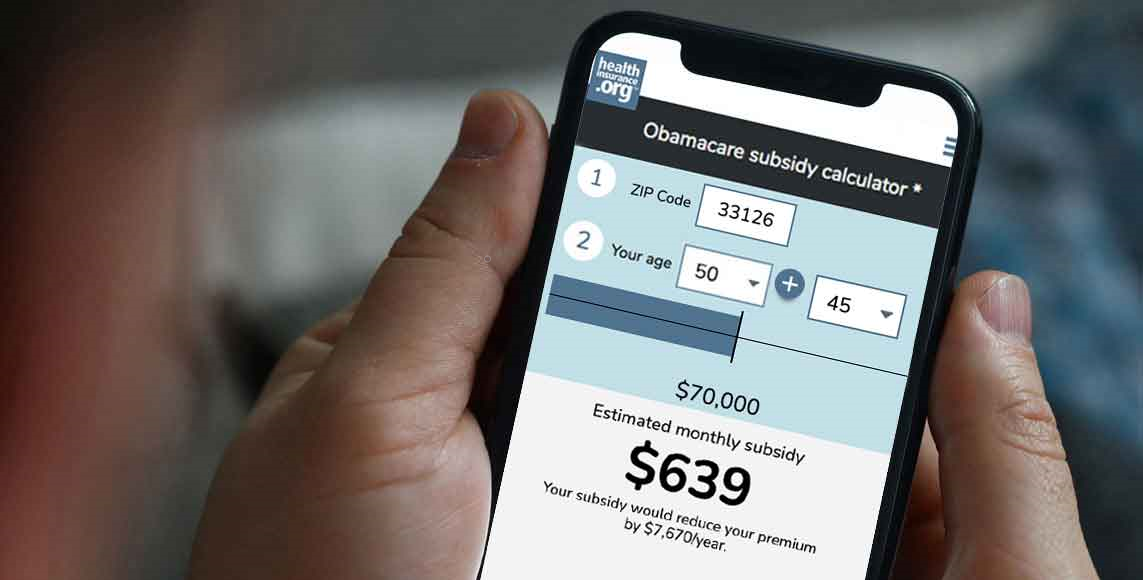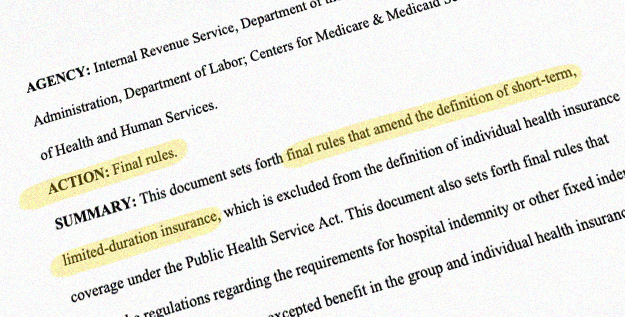Home > States > Health insurance in Wyoming
See your Wyoming health insurance coverage options.

Find individual and family plans, small-group, short-term or Medicare plans through licensed agency partners.

Wyoming Health Insurance Consumer Guide
We created this guide to help you understand the health coverage options and possible financial assistance available to you and your family in Wyoming.
Wyoming uses the federally run platform, HealthCare.gov, for enrollment in ACA Marketplace plans. The Wyoming Marketplace provides access to health insurance products from two private insurers; both offer coverage statewide.1
Depending on your income and other circumstances, you may also get help to lower your monthly insurance premium (the amount you pay to enroll in the coverage) and possibly your out-of-pocket expenses, when you enroll in a health insurance plan through the Wyoming Marketplace.
Explore our other comprehensive guides to coverage in Wyoming
Dental coverage in Wyoming

In 2023, three insurers offer stand-alone individual/family dental coverage through Wyoming’s Marketplace.2

Wyoming’s Medicaid program

Despite multiple attempts over the past several years, Wyoming remains among only a dozen states where Medicaid expansion has not been enacted.3 Wyoming's Medicaid/CHIP enrollment was 84,650 people as of April 2023.4

Medicare coverage and enrollment in Wyoming

Medicare enrollment in Wyoming stood at 122,946 people as of early 2023.5 Our guide will help you better understand Medicare coverage options and Medicare-specific regulations in Wyoming.

Short-term coverage in Wyoming

In Wyoming, short-term health insurance plans are available and adhere to federal regulations. There are at least seven insurers selling short-term health insurance plans in Wyoming in 2023.6

Frequently asked questions about health insurance in Wyoming
Who can buy Marketplace health insurance?
To qualify for health coverage through the Wyoming Marketplace, you must:7
- Live in Wyoming
- Be lawfully present in the United States
- Not be incarcerated
- Not be enrolled in Medicare
Eligibility for financial assistance in the form of premium subsidies and cost-sharing reductions depends on your income. In addition, to qualify for financial assistance with your Marketplace plan you must:
- Not have access to affordable health coverage offered by an employer. If your employer offers coverage but you feel it’s too expensive, you can use our Employer Health Plan Affordability Calculator to see if you might qualify for premium subsidies in the Marketplace.
- Not be eligible for Medicaid or CHIP.
- Not be eligible for premium-free Medicare Part A.8
When can I enroll in an ACA-compliant plan in Wyoming?
In Wyoming, you can sign up for an ACA-compliant individual or family health plan from November 1 to January 15 during open enrollment.9
If you need your coverage to start on January 1, you must apply by December 15. If you apply between December 16 and January 15, your coverage will begin on February 1.10
Outside of open enrollment, a special enrollment period (generally due to a specific qualifying life event) is necessary to enroll or make changes to your coverage.
If you have questions about open enrollment, you can learn more in our comprehensive guide to open enrollment. We also have a comprehensive guide to special enrollment periods.
How do I enroll in a Wyoming Marketplace plan?
To enroll in an ACA Marketplace plan in Wyoming, you can:
- Visit HealthCare.gov – Wyoming’s health insurance Marketplace. Here you will find an online platform to compare plans, determine whether you’re eligible for financial assistance, and enroll in the plan that best meets your needs.
- Purchase Marketplace health coverage with the help of an insurance agent or broker, a Navigator or certified application counselor, or an approved enhanced direct enrollment entity.11
- You can also call HealthCare.gov’s contact center by dialing 1-800-318-2596 (TTY: 1-855-889-4325). The call center is available 24 hours a day, seven days a week, but it’s closed on holidays.
How can I find affordable health insurance in Wyoming?
Wyoming residents use the federally run enrollment platform – HealthCare.gov – to shop for individual and family health plans.
As of 2023, about 90% of Wyoming Marketplace enrollees saved money on their premiums due to income-based advance premium tax credits (subsidies). The average subsidy savings was $873/month, providing an average after-subsidy premium of $97/month.12
People with household incomes up to 250% of the federal poverty level also qualify for cost-sharing reductions (CSR). This benefit, which is automatically added to Silver-level plans if you’re eligible for it, will reduce your out-of-pocket expenses when you use your plan.[efn_note]APTC and CSR Basics. Centers for Medicare and Medicaid Services. June 2023.[/efn_note]
Between the premium subsidies and cost-sharing reductions, you may find that an ACA health insurance plan provides the best value when you’re shopping for coverage.

Source: CMS.gov12
Wyoming has not yet expanded Medicaid eligibility under the ACA. The state legislature has considered Medicaid expansion numerous times over the years, but the legislation has never been successful. As a result, there is a coverage gap in the state: Non-disabled adults under age 65 who don’t have children are ineligible for both Medicaid and Marketplace subsidies.
How many insurers offer Marketplace coverage in Wyoming?
Two insurers offer Marketplace health insurance plans in Wyoming, and both offer coverage statewide for 2024.1
Are Marketplace health insurance premiums increasing in Wyoming?
Wyoming’s Marketplace insurers have implemented the following average rate changes for 2024, before subsidies are applied:13
Wyoming’s ACA Marketplace Plan 2024 Approved Rate Increases by Insurance Company |
|
|---|---|
| Issuer | Percent Increase |
| Blue Cross Blue Shield of Wyoming | –7.01% |
| Mountain Health CO-OP/Montana Health CO-OP | 7.59% |
Source: HealthCare.gov13
When we talk about overall average rate changes, however, we have to keep in mind that they only reflect how full-price premiums change from one year to the next. They don’t account for subsidies or for the fact that a person’s rates will increase each year based on their age, even if their insurer doesn’t change its average premiums at all.
Most enrollees in Wyoming’s exchange receive premium subsidies, which offset the majority of the cost of their coverage.12
Wyoming is one of only two states (the other is Oklahoma) where the federal government conducts the rate review process; in the rest of the country, this is done by state regulators.14
For perspective, here’s a summary of average full-price premium changes over the years in Wyoming’s individual market (note that most enrollees qualify for subsidies, and these price changes are all calculated before subsidies are applied):
- 2015: Average increase of 5%.15
- 2016: Average increase of 6% (only BCBSWY left in the Marketplace)
- 2017: Average increase of 7%.16
- 2018: Average increase of 55%.17
- 2019: Average decrease of 0.25%.18
- 2020: Average increase of 2%.19
- 2021: Average decrease of 10%.20 (and Mountain Health CO-OP joined the Marketplace)
- 2022: Average (unweighted) decrease of 4%.21
- 2023: Average increase of 19%.22
How many people are insured through Wyoming’s Marketplace?
In the open enrollment period for 2023 coverage, over 37,000 people enrolled in a health plan through the Wyoming ACA Marketplace.12 This marked the third year in a row the Wyoming Marketplace reached record-high Marketplace enrollment.
The surge in enrollment during these years was due in part to the American Rescue Plan (ARP) which made ACA’s premium subsidies more substantial. Under the ARP – now extended by the Inflation Reduction Act – subsidies are more significant and accessible through the end of 2025.23

Source: 2014,24 2015,25 2016,26 2017,27 2018,28 2019,29 2020,30 2021,31 2022,32 202312
What health insurance resources are available to Wyoming residents?
HealthCare.gov
800-318-2596
Wyoming Insurance Department
Provides consumer protection and support to Wyoming residents by investigating consumer complaints and resolving issues on insurance matters.
(307) 777-7401 / Toll Free: 1-800-438-5768 / [email protected]
State Exchange Profile: Wyoming
The Henry J. Kaiser Family Foundation overview of Wyoming’s progress toward creating a state health insurance exchange.
Louise Norris is an individual health insurance broker who has been writing about health insurance and health reform since 2006. She has written dozens of opinions and educational pieces about the Affordable Care Act for healthinsurance.org.
Footnotes
- Plan Year 2024 Qualified Health Plan Choice and Premiums in HealthCare.gov Marketplaces. Centers for Medicare and Medicaid Services. October 25, 2023. ⤶ ⤶
- “Wyoming dental insurance guide 2023” healthinsurance.org, Accessed September 2023 ⤶
- “Despite passing committee, Medicaid expansion dies without a reading on House floor” Wyoming Public Radio, Feb. 9, 2023 ⤶
- “April 2023 Medicaid & CHIP Enrollment Data Highlights” Medicaid.gov, April 28, 2023 ⤶
- “Medicare Monthly Enrollment” CMS.gov, April 2023. ⤶
- “Availability of short-term health insurance in Wyoming” healthinsurance.org, March 24, 2023 ⤶
- “A quick guide to the Health Insurance Marketplace®” HealthCare.gov, Accessed August, 2023 ⤶
- Medicare and the Marketplace, Master FAQ. Centers for Medicare and Medicaid Services. Accessed November 2023. ⤶
- “When can you get health insurance?” HealthCare.gov, 2023 ⤶
- “A quick guide to the Health Insurance Marketplace®” HealthCare.gov, Accessed August, 2023 ⤶
- “Entities Approved to Use Enhanced Direct Enrollment” CMS.gov, April 28, 2023 ⤶
- “2023 Marketplace Open Enrollment Period Public Use Files” CMS.gov, 2023 ⤶ ⤶ ⤶ ⤶ ⤶
- ”Wyoming Rate Review Submissions” HealthCare.gov, 2023 ⤶ ⤶
- State Effective Rate Review Programs. Centers for Medicare and Medicaid Services. Accessed November 2023. ⤶
- Analysis Finds No Nationwide Increase in Health Insurance Marketplace Premiums. The Commonwealth Fund. December 2014. ⤶
- Avg. UNSUBSIDIZED Indy Mkt Rate Hikes: 25% (49 States + DC). ACA Signups. October 2016. ⤶
- Alabama, Hawaii, Missouri, Wyoming: Wrapping Up The 2018 Rate Hike Project W/An Assist From Avalere. ACA Signups. October 2017. ⤶
- 2019 Rate Hikes. ACA Signups. October 2018. ⤶
- 2020 Rate Changes. ACA Signups. October 2019. ⤶
- Wyoming: Preliminary Avg. 2021 #ACA Rates: 10.0% *Decrease*. ACA Signups. October 2020. ⤶
- *APPROVED* Avg. 2022 #ACA Rate Changeapalooza! AK, CA, GA, HI, IL, KS, LA, MA, MS, MO, NE, NH, TX, WY. ACA Signups. November 2021. ⤶
- UPDATED: FINAL Unsubsidized 2023 Premiums: +6.2% Across All 50 States +DC. ACA Signups. Accessed November 2023. ⤶
- “Health Insurance Marketplaces 2023 Open Enrollment Report” CMS.gov, Accessed August 2023 ⤶
- “ASPE Issue Brief (2014)” ASPE, 2015 ⤶
- “Health Insurance Marketplaces 2015 Open Enrollment Period: March Enrollment Report”, HHS.gov, 2015 ⤶
- “HEALTH INSURANCE MARKETPLACES 2016 OPEN ENROLLMENT PERIOD: FINAL ENROLLMENT REPORT” HHS.gov, 2016 ⤶
- “2017 Marketplace Open Enrollment Period Public Use Files” CMS.gov, 2017 ⤶
- “2018 Marketplace Open Enrollment Period Public Use Files” CMS.gov, 2018 ⤶
- “2019 Marketplace Open Enrollment Period Public Use Files” CMS.gov, 2019 ⤶
- “2020 Marketplace Open Enrollment Period Public Use Files” CMS.gov, 2020 ⤶
- “2021 Marketplace Open Enrollment Period Public Use Files” CMS.gov, 2021 ⤶
- “2022 Marketplace Open Enrollment Period Public Use Files” CMS.gov, 2022 ⤶







